Improving the Efficiency of Maritime Infrastructures through a BIM-Based Building Energy Modelling Approach: A Case Study in Naples, Italy
Abstract
:1. Introduction
1.1. Renovation or Redevelopment Project of Port Areas
1.2. Application of BIM and BEM Methodologies
2. Materials and Methods
2.1. Case Study
- The construction of a Commercial Area directly connected with the metro station of “Piazza Municipio”;
- Re-arrangement of the “Molo Beverello” area, directly connected to the Commercial Area and to the pedestrian tunnel coming from the adjacent subway station. This project includes the construction of a new passenger terminal station for the fast sea lines to the islands of the Gulf of Naples.
2.2. Data Collection
2.3. BIM Model Development
2.4. BEM Model Development
2.5. Model Manipulation and Review
- -
- Proposed System 1 (PS1), water-source heat pump;
- -
- Proposed System 2 (PS2), heat recovery from chiller condensers;
- -
- Proposed System 3 (PS3), replacement of window facade with photovoltaic glass;
- -
- Proposed System 4 (PS4), replacement of shading systems with photovoltaic canopies.
2.5.1. Proposed System 1: Water-Source Heat Pump
2.5.2. Proposed System 2: Heat Recovery from Chiller Condenser
- Electricity for heating is expected to decrease, as the higher the recovery temperature, the lower the thermal power required for reheat coil;
- Electricity for cooling is expected to increase, as the higher the recovery temperature, thus condensing temperature, the lower is the efficiency of the machines;
- Total electricity for heating and cooling is the total electricity required by chillers and is the parameter to optimise.
2.5.3. Proposed System 3: Replacement of Window Façade
2.5.4. Proposed System 4: Photovoltaic Canopies
2.6. Simulation and Post Processing
3. Results and Discussion
3.1. Reference Building
3.2. Water Source Heat Pump
3.3. Heat Recovery from Chiller Condenser
3.4. Replacement of Window Façade
3.5. Photovoltaic Canopies
3.6. Economic Assessment of Proposed Systems
3.7. About BIM to BEM Methodology
3.8. Continous Improvement in Port Building Management
4. Conclusions
Author Contributions
Funding
Institutional Review Board Statement
Informed Consent Statement
Data Availability Statement
Conflicts of Interest
Nomenclature
| AEC | Architecture, Engineering and Construction |
| AHU | Air Handling Units |
| ASHP | Air Source Heat Pump |
| BEM | Building Energy Modeling |
| BEST | Building Energy Software Tools |
| BIM | Building Information Modeling |
| BPS | whole-Building Performance Simulations |
| CFD | Computational Fluid Dynamics |
| DOE | Departement of Energy |
| ESPO | European Sea Ports Organisation |
| HVAC | Heating, Ventilation, and Air Conditioning |
| IDP | Integrated Design Process |
| IFC | Industry Foundation Classes |
| LCA | Life Cycle Assessment |
| MEP | Mechanical, Electrical, and Plumbing |
| nZEB | nearly Zero Energy Building |
| PDCA | Plan, Do, Check, Act |
| PERS | Port Environmental Review System |
| PLR | Part Load Ratio |
| PROP | Proposed Building |
| PS | Proposed System |
| REF | Reference Building |
| WSHP | Water Source Heat Pump |
References
- Darbra Roman, R.M.; Wooldridge, C.; Puig Duran, M. Available online: https://upcommons.upc.edu/handle/2117/333594?show=full (accessed on 10 June 2021).
- Barone, G.; Buonomano, A.; Forzano, C.; Palombo, A. Implementing the dynamic simulation approach for the design and optimization of ships energy systems: Methodology and applicability to modern cruise ships. Renew. Sustain. Energy Rev. 2021, 150, 111488. [Google Scholar] [CrossRef]
- Barone, G.; Buonomanoab, A.; Forzano, C. Sustainable energy design of cruise ships through dynamic simulations: Multi-objective optimization for waste heat recovery. Energy Convers. Manag. 2020, 221, 113–166. [Google Scholar] [CrossRef]
- Barone, G.; Buonomano, A.; Forzano, C.; Giuzio, G.F.; Palombo, A. Increasing renewable energy penetration and energy independence of island communities: A novel dynamic simulation approach for energy, economic, and environmental analysis, and optimization. J. Clean. Prod. 2021, 311, 127558. [Google Scholar] [CrossRef]
- Maturo, A.; Petrucci, A.; Forzano, C.; Giuzio, G.F.; Buonomano, A.; Athienitis, A. Design and environmental sustainability assessment of energy-independent communities: The case study of a livestock farm in the North of Italy. Energy Rep. 2021. [Google Scholar] [CrossRef]
- Barone, G.; Buonomano, A.; Forzano, C. Increasing self-consumption of renewable energy through the Building to Vehicle to Building approach applied to multiple users connected in a virtual micro-grid. Renew. Energy 2020, 159, 1165–1176. [Google Scholar] [CrossRef]
- Sdoukopoulos, E.; Boile, M.; Tromaras, A.; Anastasiadis, N. Energy Efficiency in European Ports: State-Of-Practice and Insights on the Way Forward. Sustainability 2019, 11, 4952. [Google Scholar] [CrossRef] [Green Version]
- Hippinen, I.; Federley, J. Fact-Finding Study on Opportunities to Enhance the Energy Efficiency and Environmental Impacts of Ports in the Baltic Sea Region; Study of the Baltic Sea Region Energy Cooperation (BASREC): Helsinki, Finland, 2014. [Google Scholar]
- Yu, S. Introduction of Water Source Heat Pump System. In Handbook of Energy Systems in Green Buildings; Wang, R., Zhai, X., Eds.; Springer: Berlin/Heidelberg, Germany, 2018; pp. 473–519. [Google Scholar] [CrossRef]
- Pitaccolo, M. Action Plan for a Sustainable and Low Carbon Port of Venice and Chioggia. Available online: https://supair.adrioninterreg.eu/wp-content/uploads/2020/03/SUPAIR_DT1.4.1_Action-Plan-for-a-Sustainable-and-low-carbon-port-of-Venice_dec-2019.pdf (accessed on 10 June 2021).
- Carou, F. Port Lands Energy Plan—Guidelines for a Net Zero District. Available online: https://portlandsto.ca/wp-content/uploads/Port+Lands+Energy+Plan_Sep+2017.pdf (accessed on 10 June 2021).
- Vaher, K.; Maivel, M.; Haab, P. Sustainable Energetic Solutions for Cruise Terminal Buildings. Available online: http://www.greencruiseport.eu/sustainable-energetic-solutions-for-cruise-terminal-buildings.html (accessed on 10 June 2021).
- EQUA. IDA Indoor Climate and Energy. Available online: https://www.equa.se/en/ida-ice (accessed on 10 June 2021).
- Elnabawi, M.H. Building Information Modeling-Based Building Energy Modeling: Investigation of Interoperability and Simulation Results. Front. Built Environ. 2020, 6, 193. [Google Scholar] [CrossRef]
- Buonomano, A.; Montanaroa, U.; Palomboa, A. Temperature and humidity adaptive control in multi-enclosed thermal zones under unexpected external disturbances. Energy Build. 2017, 135, 263–285. [Google Scholar] [CrossRef]
- Barone, G.; Zacharopoulos, A.; Buonomano, A.; Forzano, C.; Giuzio, G.F.; Mondol, J.; Palombo, A.; Pugsley, A.; Smyth, M. Concentrating Photovoltaic Glazing (CoPVG) system: Modelling and simulation of smart building façade. Energy 2021, in press. [Google Scholar] [CrossRef]
- Barone, G.; Buonomano, A.; Forzano, C.; Giuzio, G.F.; Palombo, A. Passive and active performance assessment of building integrated hybrid solar photovoltaic/thermal collector prototypes: Energy, comfort, and economic analyses. Energy 2020, 209, 118435. [Google Scholar] [CrossRef]
- Buonomano, A.; Palombo, A. Building energy performance analysis by an in-house developed dynamic simulation code: An investigation for different case studies. Appl. Energy 2014, 113, 788–807. [Google Scholar] [CrossRef]
- Barone, G.; Buonomano, A.; Forzano, C.; Palombo, A. Building Energy Performance Analysis: An Experimental Validation of an In-House Dynamic Simulation Tool through a Real Test Room. Energies 2019, 12, 4107. [Google Scholar] [CrossRef] [Green Version]
- Mazzarella, L.; Pasini, M. OpenBPS: A New Building Performance Simulation Tool. 2017, pp. 217–224. Available online: http://www.ibpsa.org/proceedings/BSA2017/9788860461360_27.pdf/ (accessed on 10 June 2021).
- Barone, G.; Buonomano, A.; Calise, F.; Forzano, C.; Palombo, A. WLHP Systems in Commercial Buildings: A Case Study Analysis Based on a Dynamic Simulation Approach. Am. J. Eng. Appl. Sci. 2016, 9, 659–668. [Google Scholar] [CrossRef] [Green Version]
- Barone, G.; Buonomano, A.; Calise, F.; Forzano, C.; Palombo, A. Energy recovery through natural gas turboexpander and solar collectors: Modelling and thermoeconomic optimization. Energy 2019, 183, 1211–1232. [Google Scholar] [CrossRef]
- Barone, G.; Buonomano, A.; Forzano, C.; Palombo, A. A novel dynamic simulation model for the thermo-economic analysis and optimisation of district heating systems. Energy Convers. Manag. 2020, 220, 113052. [Google Scholar] [CrossRef]
- Barone, G.; Buonomano, A.; Forzano, C.; Palombo, A. Enhancing trains envelope—Heating, ventilation, and air conditioning systems: A new dynamic simulation approach for energy, economic, environmental impact and thermal comfort analyses. Energy 2020, 204, 117833. [Google Scholar] [CrossRef]
- Gao, H.; Koch, C.; Wu, Y. Building information modelling based building energy modelling: A review. Appl. Energy 2019, 238, 320–343. [Google Scholar] [CrossRef]
- Larsson, N. The Integrated Design Process; History and Analysis. 2009. Available online: https://www.semanticscholar.org/paper/The-Integrated-Design-Process-%3B-History-and-Larsson/2b55fe3ce399e2d41659349c936b0f5245e01563 (accessed on 10 June 2021).
- Wen, Q.-J.; Ren, Z.-J.; Lu, H.; Wu, J.-F. The progress and trend of BIM research: A bibliometrics-based visualization analysis. Autom. Constr. 2021, 124, 103558. [Google Scholar] [CrossRef]
- Zhuang, D.; Zhang, X.; Lu, Y.; Wang, C.; Jin, X.; Zhou, X.; Shi, X. A performance data integrated BIM framework for building life-cycle energy efficiency and environmental optimization design. Autom. Constr. 2021, 127, 103712. [Google Scholar] [CrossRef]
- Bastos Porsani, G.; Del Valle de Lersundi, K.; Sánchez-Ostiz Gutiérrez, A.; Fernández Bandera, C. Interoperability between Building Information Modelling (BIM) and Building Energy Model (BEM). Appl. Sci. 2021, 11, 2167. [Google Scholar] [CrossRef]
- Industy Foundation Classes (IFC). Available online: https://www.buildingsmart.org/standards/bsi-standards/industry-foundation-classes/ (accessed on 10 June 2021).
- Studio, G.B. Green Building XML (gbXML). Available online: https://www.gbxml.org/About_GreenBuildingXML_gbXML (accessed on 10 June 2021).
- Pezeshki, Z.; Soleimani, A.; Darabi, A. Application of BEM and using BIM database for BEM: A review. J. Build. Eng. 2019, 23, 1–17. [Google Scholar] [CrossRef]
- Kamel, E.; Memari, A.M. Review of BIM’s application in energy simulation: Tools, issues, and solutions. Autom. Constr. 2019, 97, 164–180. [Google Scholar] [CrossRef]
- Gourlis, G.; Kovacic, I. Building Information Modelling for analysis of energy efficient industrial buildings—A case study. Renew. Sustain. Energy Rev. 2017, 68, 953–963. [Google Scholar] [CrossRef]
- de Lima Montenegro Duarte, J.G.C.; Ramos Zemero, B.; Dias Barreto de Souza, A.C.; de Lima Tostes, M.E.; Holanda Bezerra, U. Building Information Modeling approach to optimize energy efficiency in educational buildings. J. Build. Eng. 2021, 43, 102587. [Google Scholar] [CrossRef]
- Donnell, J.; Maile, T.; Rose, C.; Mrazović, N.; Morrissey, E.; Parrish, K.; Regnier, C.; Bazjanac, V. Transforming BIM to BEM: Generation of Building Geometry for the NASA Ames Sustainability Base BIM. Available online: https://www.osti.gov/servlets/purl/1168736 (accessed on 10 June 2021).
- El Sayary, S.; Omar, O. Designing a BIM energy-consumption template to calculate and achieve a net-zero-energy house. Sol. Energy 2021, 216, 315–320. [Google Scholar] [CrossRef]
- Schlueter, A.; Thesseling, F. Building information model based energy/exergy performance assessment in early design stages. Autom. Constr. 2009, 18, 153–163. [Google Scholar] [CrossRef]
- Tushar, Q.; Bhuiyan, M.A.; Zhang, G.; Maqsood, T. An integrated approach of BIM-enabled LCA and energy simulation: The optimized solution towards sustainable development. J. Clean. Prod. 2021, 289, 125622. [Google Scholar] [CrossRef]
- Bonomolo, M.; Di Lisi, S.; Leone, G. Building Information Modelling and Energy Simulation for Architecture Design. Appl. Sci. 2021, 11, 2252. [Google Scholar] [CrossRef]
- Bracht, M.K.; Melo, A.P.; Lamberts, R. A metamodel for building information modeling-building energy modeling integration in early design stage. Autom. Constr. 2021, 121, 103422. [Google Scholar] [CrossRef]
- Sušnik, M.; Tagliabue, L.C.; Cairoli, M. BIM-based energy and acoustic analysis through CVE tools. Energy Rep. 2021. In Press. [Google Scholar] [CrossRef]
- Abbasi, S.; Noorzai, E. The BIM-Based multi-optimization approach in order to determine the trade-off between embodied and operation energy focused on renewable energy use. J. Clean. Prod. 2021, 281, 125359. [Google Scholar] [CrossRef]
- Utkucu, D.; Sözer, H. Interoperability and data exchange within BIM platform to evaluate building energy performance and indoor comfort. Autom. Constr. 2020, 116, 103225. [Google Scholar] [CrossRef]
- Rocha, A.; Pinto, D.; Ramos, N.M.M.; Almeida, R.M.S.F.; Barreira, E.; Simões, M.L.; Martins, J.P.; Pereira, P.F.; Sanhudo, L. A case study to improve the winter thermal comfort of an existing bus station. J. Build. Eng. 2020, 29, 101123. [Google Scholar] [CrossRef]
- Kota, S.; Haberl, J.S.; Clayton, M.J.; Yan, W. Building Information Modeling (BIM)-based daylighting simulation and analysis. Energy Build. 2014, 81, 391–403. [Google Scholar] [CrossRef]
- Brancaccio Costruzioni Spa. Available online: http://www.brancacciospa.it/ (accessed on 10 June 2021).
- Michel, B. EBSG Architectes. Available online: http://www.ebsg.fr (accessed on 10 June 2021).
- Rospi, G.; Cardinale, N.; Intini, F.; Cardinale, T. Analysis of Energy Consumption of Different Typologies of School Buildings in the City of Matera (Southern Italy). Energy Procedia 2015, 82, 512–518. [Google Scholar] [CrossRef] [Green Version]
- Architects, A.I.o. AIA. Available online: https://www.aia.org/ (accessed on 10 June 2021).
- Andriamamonjy, A.; Saelens, D.; Klein, R. A combined scientometric and conventional literature review to grasp the entire BIM knowledge and its integration with energy simulation. J. Build. Eng. 2019, 22, 513–527. [Google Scholar] [CrossRef]
- Forzano, C.; Baggio, P.; Buonomano, A.; Palombo, A. Building integrating phase change materials: A dynamic hygrothermal simulation model for system analysis. J. Sustain. Dev. Energy Water Environ. Syst. 2019, 7, 325–342. [Google Scholar] [CrossRef]
- Athienitis, A.K.; Barone, G.; Buonomano, A.; Palombo, A. Assessing active and passive effects of façade building integrated photovoltaics/thermal systems: Dynamic modelling and simulation. Appl. Energy 2018, 209, 355–382. [Google Scholar] [CrossRef]

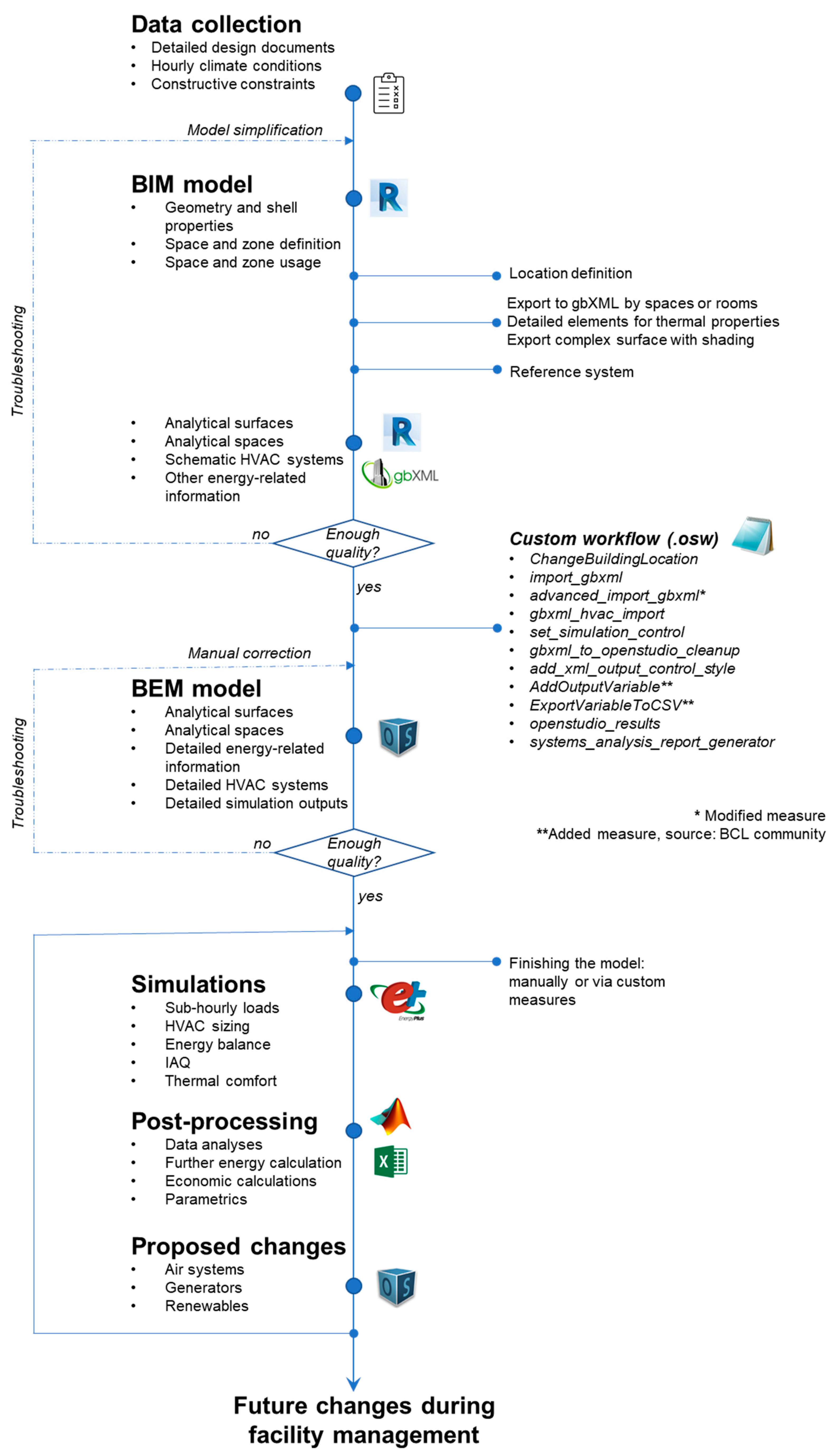

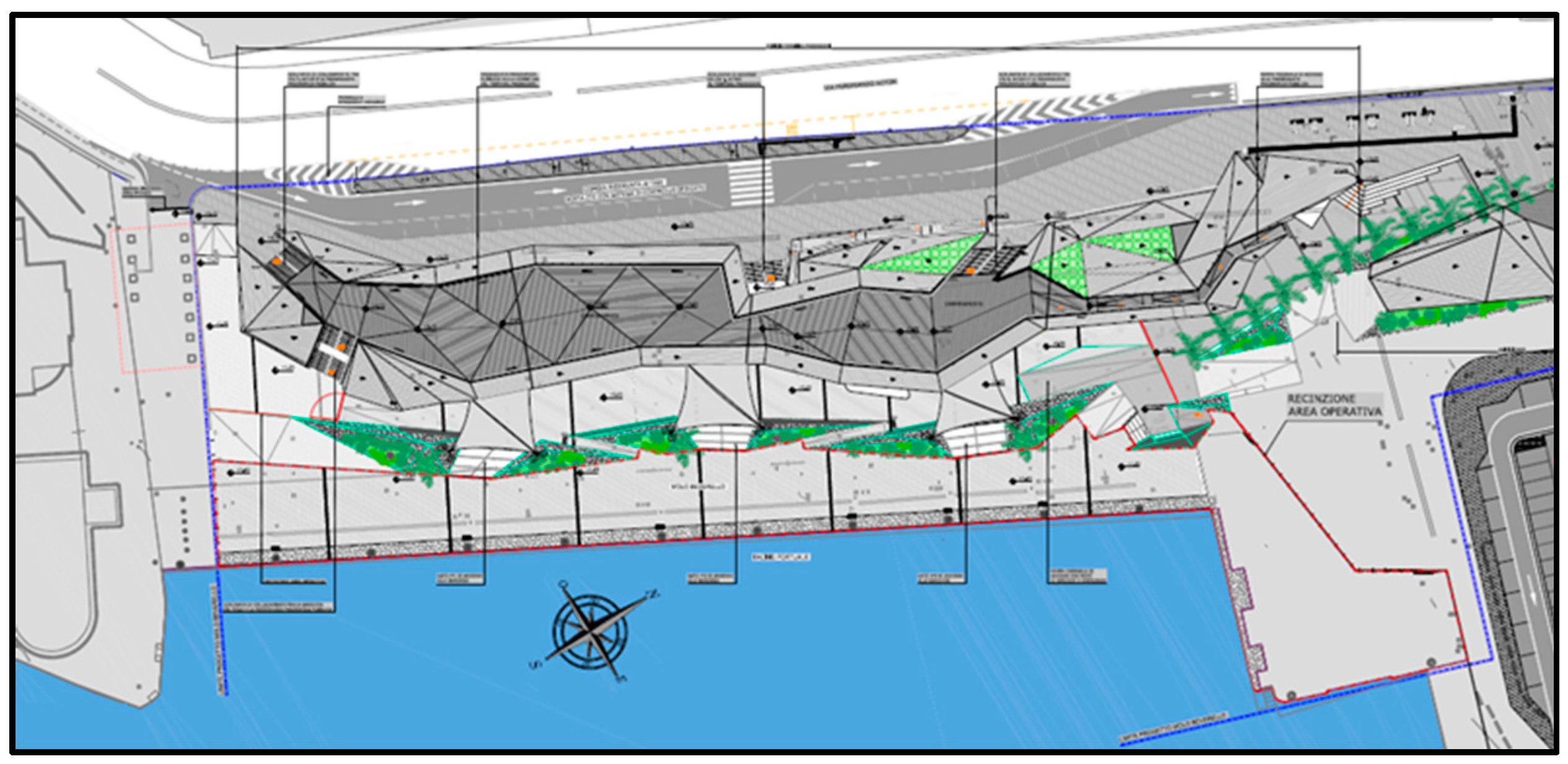

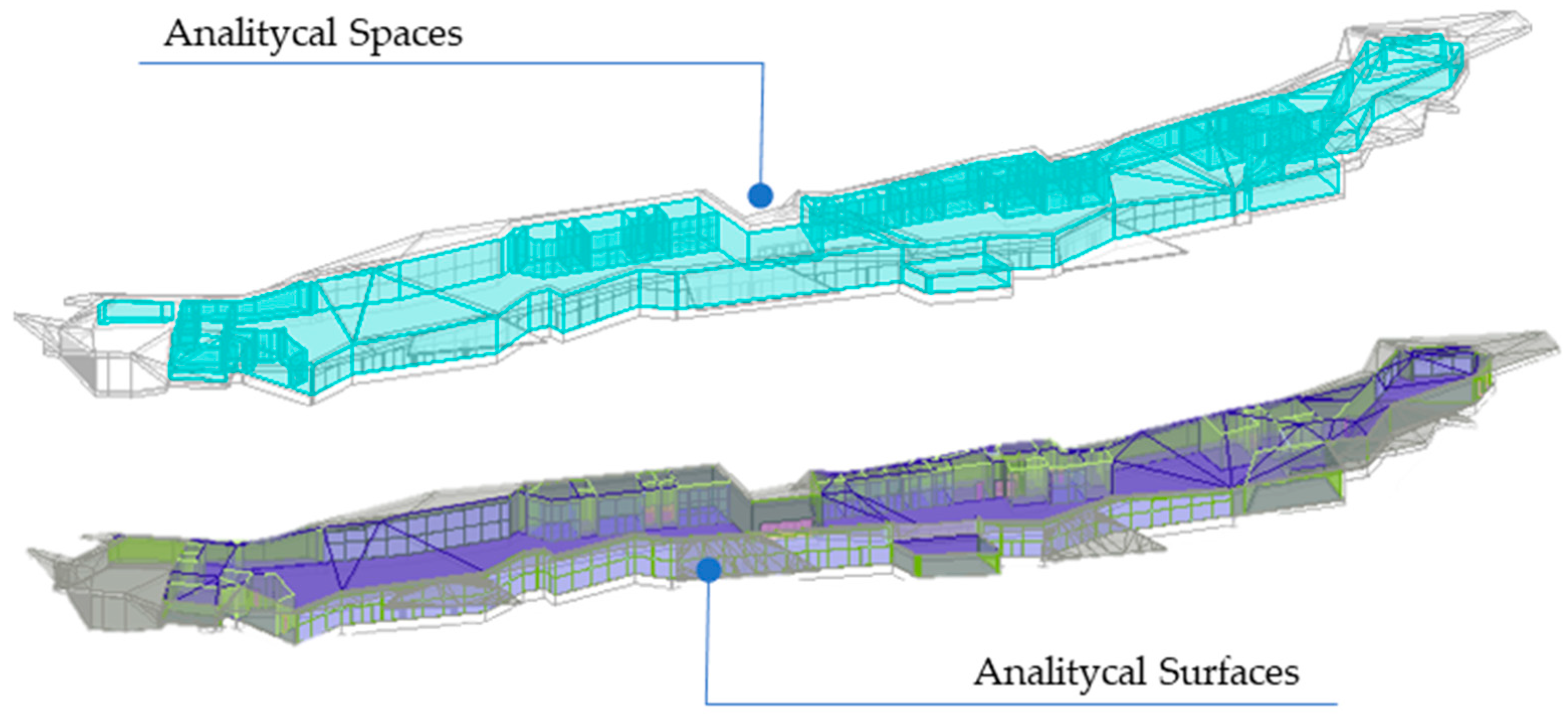
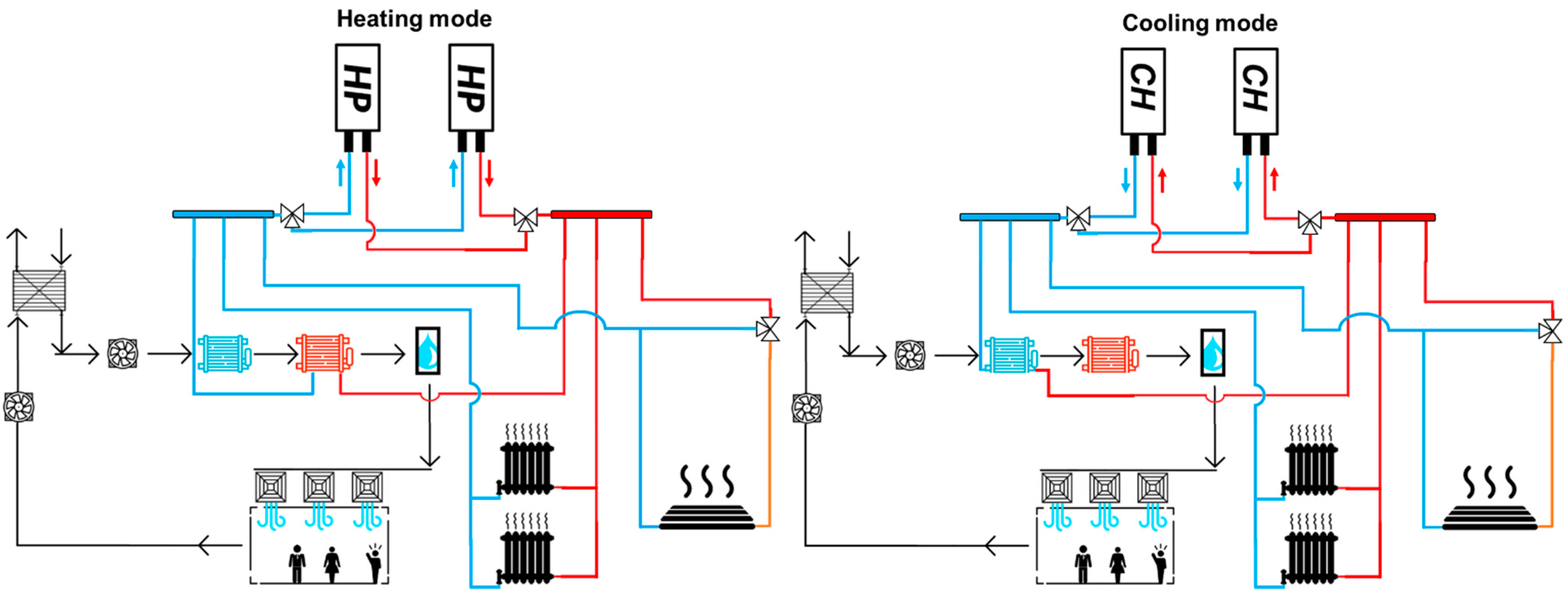


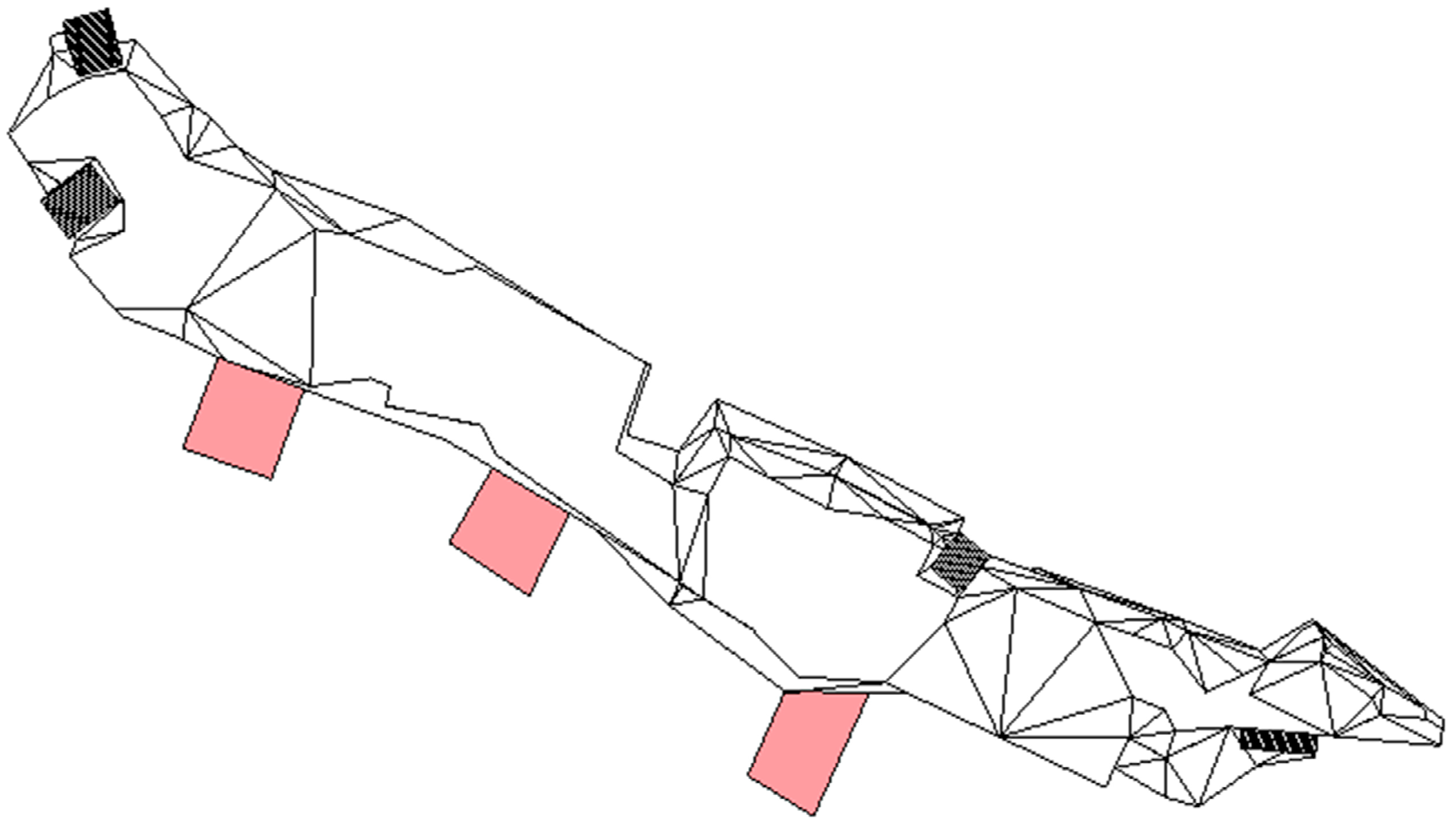

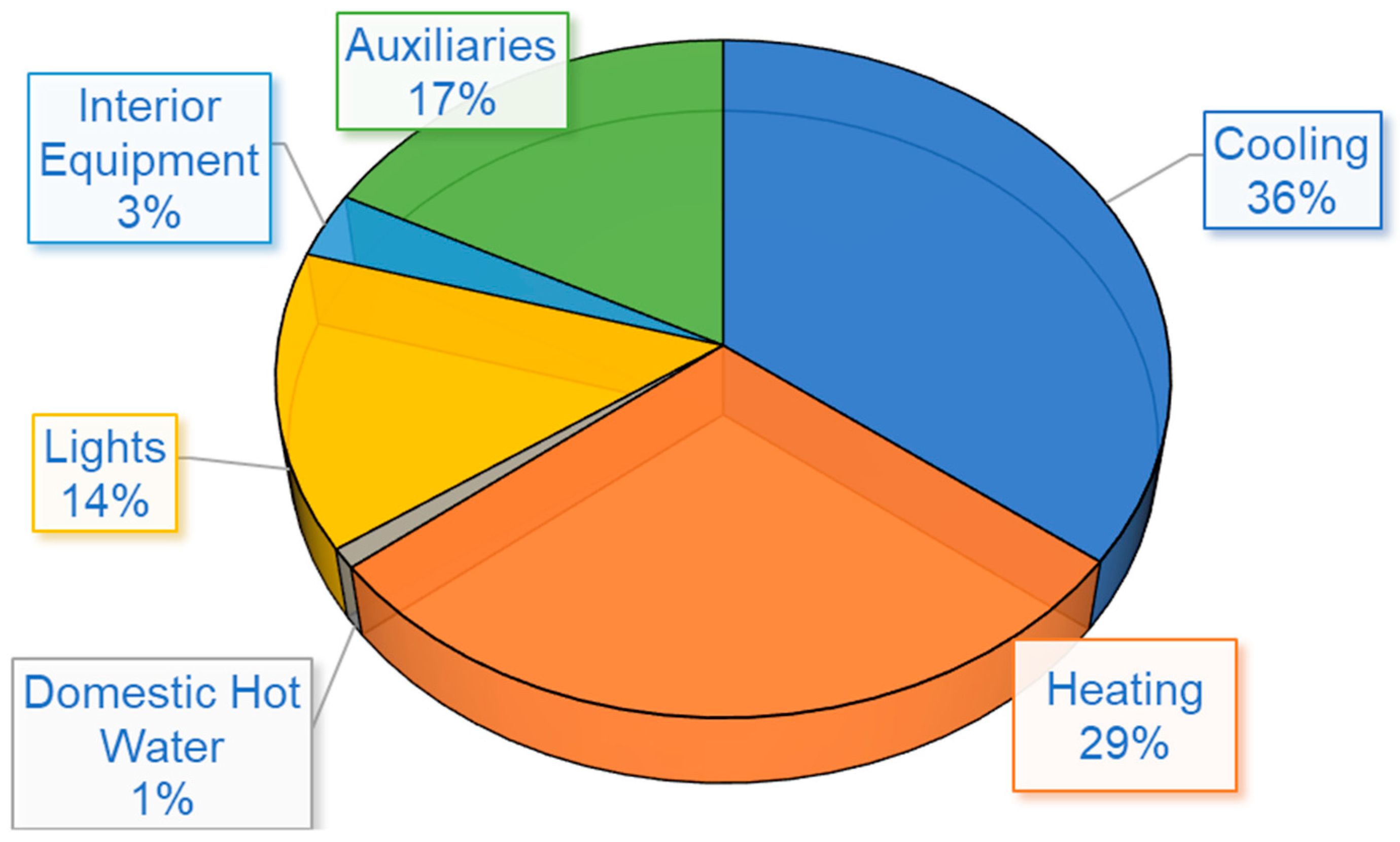
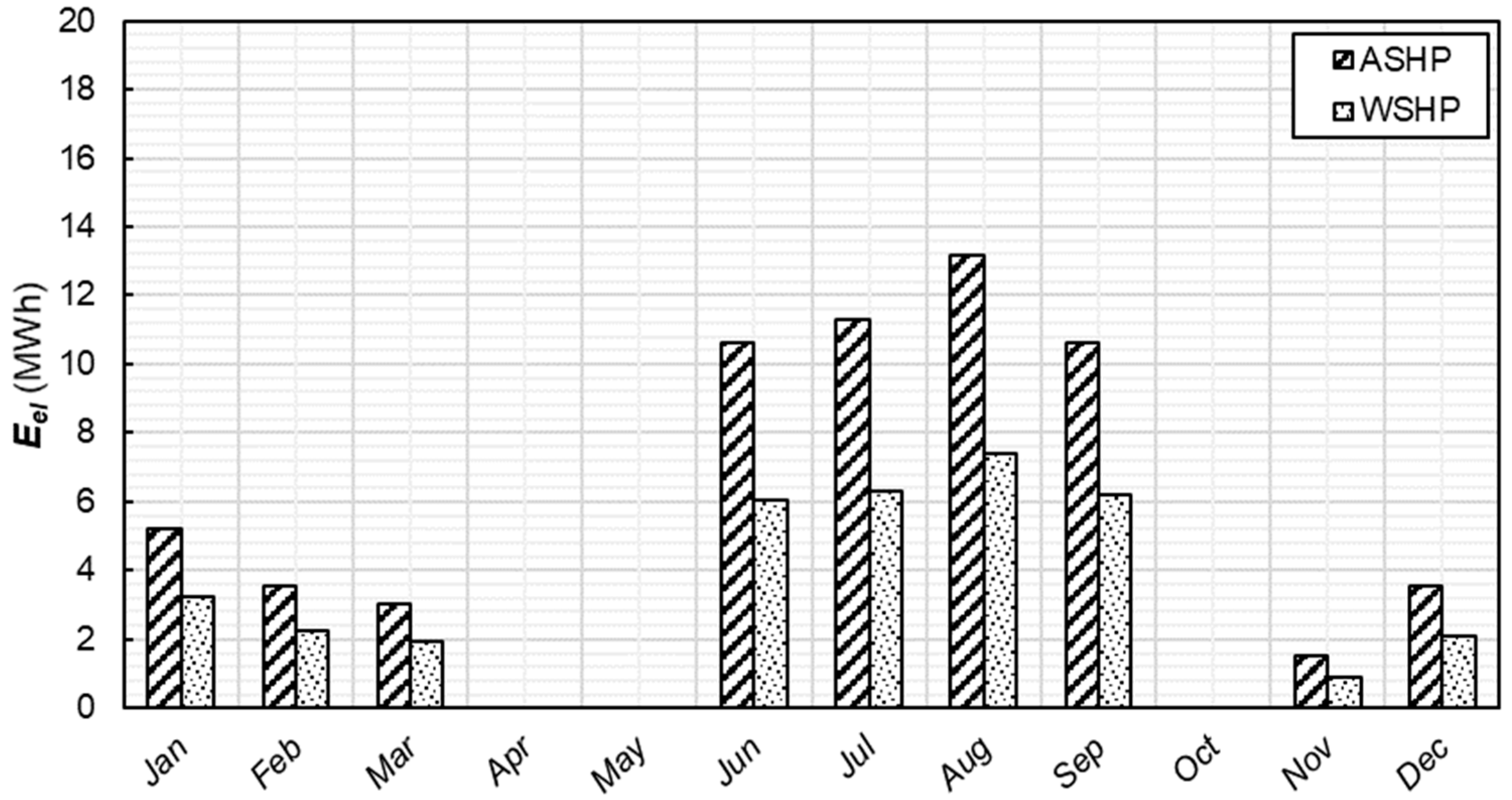

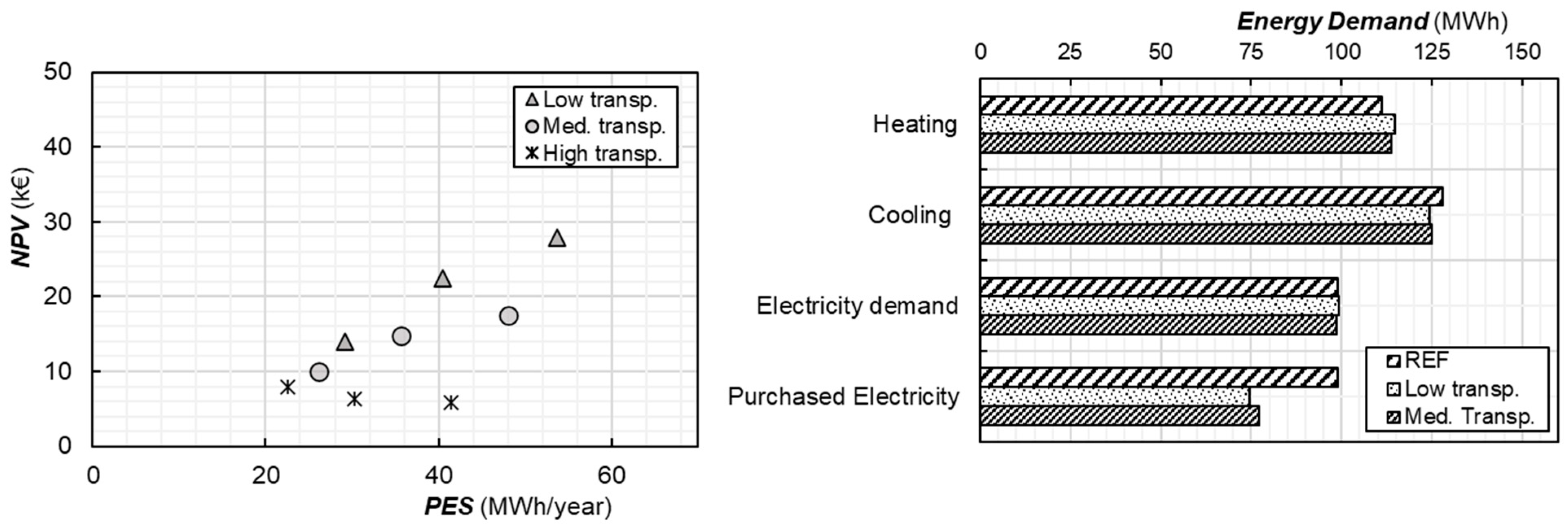


| Surface Type | U Value (W/m2K) | Thermal Mass (kJ/m2K) | SHGC (-) |
|---|---|---|---|
| Window façade | 1.25 | - | 0.2 |
| External wall | 0.36–0.56 | 318–544 | - |
| Internal wall | 0.36–3.3 | 38–544 | - |
| Floor | 0.28–0.31 | 1197–1243 | - |
| Ceiling | 0.31 | 877 | - |
| Zone | Name | Type of Space | Area (m2) | Volume (m3) | Number of People | HVAC Type |
|---|---|---|---|---|---|---|
| North bathroom | T.33 W.C. | Toilets | 23 | 90.75 | 2 | Heating and cooling; AHU; radiant systems |
| T.34 W.C. | Toilets | 23 | 96.12 | 2 | ||
| T.34_1 W.C. service | Toilets | 3 | 12.42 | 1 | ||
| T.35 W.C. | Toilets | 4 | 16.17 | 1 | ||
| West bathroom | T.24 W.C. | Toilets | 8 | 31.42 | 1 | Heating and cooling; AHU; radiant systems |
| T.25 W.C. | Toilets | 8 | 30.36 | 1 | ||
| T.26 W.C. | Toilets | 3 | 13.21 | 1 | ||
| T.27 W.C. | Toilets | 4 | 14.76 | 1 | ||
| T.27_1 Storage | Storage area | 4 | 11.29 | 1 | ||
| South bathroom | T.2 + T.5 W.C. | Toilets | 56 | 185.79 | 6 | Heating and cooling; AHU; radiant systems |
| T.3 W.C. | Toilets | 3 | 11.19 | 1 | ||
| T.4 W.C. service | Toilets | 4 | 14.19 | 1 | ||
| T.7 W.C. | Dressing room | 7 | 25.33 | 1 | ||
| Rad. west 1 | T.9 WC | Toilets | 4 | 17.23 | 1 | Heating and cooling; AHU; radiant systems |
| Rad. west 2 | T.12 WC | Toilets | 4 | 16.86 | 1 | Heating and cooling; AHU; radiant systems |
| T.14 WC | Toilets | 4 | 16.91 | 1 | ||
| Terminal | T.0 Terminal | Tickets | 1612 | 6252.23 | 322 | Heating and cooling; AHU; Low temperature radiant systems |
| T.6 Bar | Commercial | 22 | 78.25 | 4 | ||
| T.8 Storage | Commercial | 18 | 75.32 | 3 | ||
| T.10 Storage | Storage area | 3 | 10.86 | 1 | ||
| T.11 Store | Commercial | 22 | 93.5 | 3 | ||
| T.13 Storage | Storage area | 2 | 10.61 | 1 | ||
| T.15 Storage | Storage area | 2 | 10.64 | 1 | ||
| T.16 Store | Commercial | 21 | 89.97 | 3 | ||
| T.17 Office | Office | 10 | 36.08 | 1 | ||
| T.18 Office | Office | 9 | 31.38 | 1 | ||
| T.19 Office | Office | 9 | 31.78 | 1 | ||
| T.20 Office | Office | 9 | 32.36 | 1 | ||
| T.21 Office | Office | 9 | 33.45 | 1 | ||
| T.22 Office | Office | 9 | 33.4 | 1 | ||
| T.23 Meeting | Meeting room | 16 | 60.53 | 8 | ||
| T.28 Office | Office | 18 | 68.26 | 1 | ||
| T.30 Infirmary | Infirmary | 9 | 32.3 | 1 | ||
| - | T.0_1 Terminal | Entrance | 178 | 476.8 | 36 | AHU |
| - | T.1.B | Technical room | 7 | 15.62 | 0 | Unconditioned |
| - | T.1.C | Technical room | 16 | 34.79 | 0 | Unconditioned |
| - | T.29 Rack | Technical room | 4 | 12.26 | 0 | Unconditioned |
| - | T.31 | Technical room | 106 | 341.93 | 3 | Unconditioned |
| - | T.36 | Technical room | 1 | 1.84 | 0 | Unconditioned |
| - | T.37 | Technical room | 12 | 27.82 | 0 | Unconditioned |
| - | T.38 | Technical room | 2 | 7.58 | 0 | Unconditioned |
| - | T.39 | Technical room | 52 | 171.97 | 2 | Unconditioned |
| SHGC (%) | U-Value (W/m2K) | Efficiency (%) | Transparency (%) | Cost (EUR/m2) | |
|---|---|---|---|---|---|
| Low transparency | 9% | 1.2 | 4% | 10% | 107 |
| Medium transparency | 12% | 1.2 | 3.4% | 20% | 110 |
| High transparency | 17% | 1.2 | 2.8% | 30% | 115 |
| Thermal Energy (MWh/Year) | Electricity (MWh/Year) | Primary Energy (MWh/Year) | |
|---|---|---|---|
| Heating | 108.7 | 26.9 | 27.6 |
| Cooling | 127.1 | 34.9 | 35.8 |
| Domestic hot water | 4.1 | 0.9 | 0.9 |
| Himidifier | - | 3.4 | 3.5 |
| Lights | - | 13.4 | 13.7 |
| Interior equipment | - | 2.9 | 2.9 |
| Fans | - | 14.3 | 14.7 |
| Pumps | - | 2.4 | 2.5 |
| Total | 239.9 | 99.1 | 101.6 |
| Electricity (MWh/Year) | Primary Energy (MWh/Year) | CO2 Emission (t/Year) | PES (%) | |
|---|---|---|---|---|
| REF | 62.7 | 136.3 | 27.2 | - |
| PS1 | 36.6 | 79.6 | 15.9 | 41.6 |
| Electricity (MWh/Year) | Primary Energy (MWh/Year) | CO2 Emission (tons/Year) | PES (%) | |
|---|---|---|---|---|
| REF | 62.7 | 136.3 | 27.2 | - |
| PS2 | 56.3 | 122.4 | 22.5 | 10.2 |
| Electricity Demand (MWh/Year) | Purchased Electricity (MWh/Year) | Primary Energy (MWh/Year) | CO2 Emission (tons/Year) | PES (%) | |
|---|---|---|---|---|---|
| REF | 99.1 | 99.1 | 215.4 | 43.1 | - |
| PS3 Low-T | 99.2 | 74.6 | 162.2 | 32.4 | 24.7 |
| PS3 Medium-T | 99.0 | 77.3 | 168.1 | 33.6 | 24.3 |
| Electricity Demand (MWh/Year) | Purchased Electricity (MWh/Year) | Primary Energy (MWh/Year) | CO2 Emission (tons/Year) | PES (%) | |
|---|---|---|---|---|---|
| REF | 99.1 | 99.1 | 215.4 | 43.1 | - |
| PS4 | 99.1 | 58.7 | 127.6 | 25.5 | 40.7 |
| Savings (k EUR/Year) | Eel Sold (k EUR/Year) | SPB (Year) | NPV (k EUR) | PI (-) | |
|---|---|---|---|---|---|
| PS1: WSHP | 5.2 | - | 7.6 | 25.1 | 0.6 |
| PS2: Heat recovery | 1.3 | - | 1.6 | 13.9 | 7.0 |
| PS3: Low-T PVs | 4.9 | 0.8 | 7.6 | 27.9 | 0.6 |
| PS3: Medium-T PVs | 4.3 | 0.7 | 9 | 17.5 | 0.4 |
| PS4: PV canopies | 8.1 | 1.3 | 9.8 | 25.0 | 0.3 |
Publisher’s Note: MDPI stays neutral with regard to jurisdictional claims in published maps and institutional affiliations. |
© 2021 by the authors. Licensee MDPI, Basel, Switzerland. This article is an open access article distributed under the terms and conditions of the Creative Commons Attribution (CC BY) license (https://creativecommons.org/licenses/by/4.0/).
Share and Cite
Barone, G.; Buonomano, A.; Forzano, C.; Giuzio, G.F.; Palombo, A. Improving the Efficiency of Maritime Infrastructures through a BIM-Based Building Energy Modelling Approach: A Case Study in Naples, Italy. Energies 2021, 14, 4854. https://doi.org/10.3390/en14164854
Barone G, Buonomano A, Forzano C, Giuzio GF, Palombo A. Improving the Efficiency of Maritime Infrastructures through a BIM-Based Building Energy Modelling Approach: A Case Study in Naples, Italy. Energies. 2021; 14(16):4854. https://doi.org/10.3390/en14164854
Chicago/Turabian StyleBarone, Giovanni, Annamaria Buonomano, Cesare Forzano, Giovanni Francesco Giuzio, and Adolfo Palombo. 2021. "Improving the Efficiency of Maritime Infrastructures through a BIM-Based Building Energy Modelling Approach: A Case Study in Naples, Italy" Energies 14, no. 16: 4854. https://doi.org/10.3390/en14164854
APA StyleBarone, G., Buonomano, A., Forzano, C., Giuzio, G. F., & Palombo, A. (2021). Improving the Efficiency of Maritime Infrastructures through a BIM-Based Building Energy Modelling Approach: A Case Study in Naples, Italy. Energies, 14(16), 4854. https://doi.org/10.3390/en14164854










